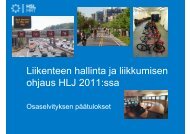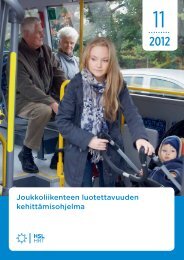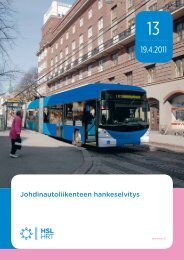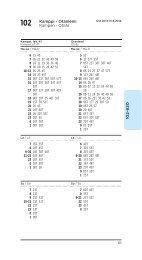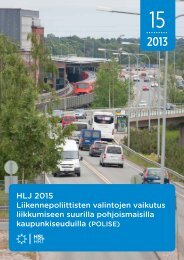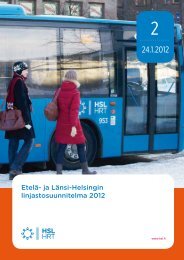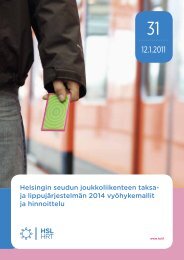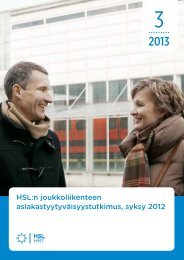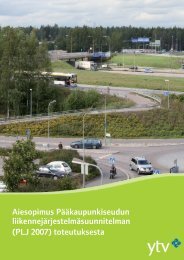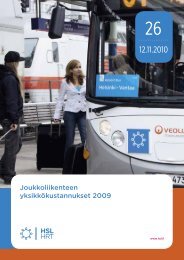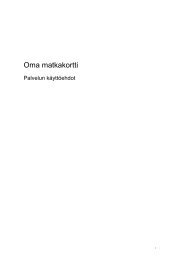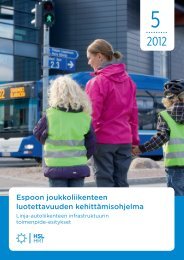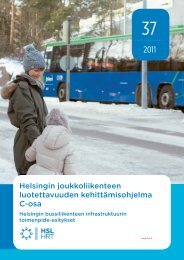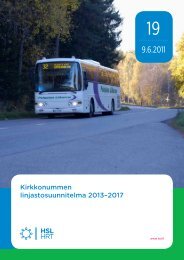HSL-alueen runkobussilinjasto 2012-2022
HSL-alueen runkobussilinjasto 2012-2022
HSL-alueen runkobussilinjasto 2012-2022
Create successful ePaper yourself
Turn your PDF publications into a flip-book with our unique Google optimized e-Paper software.
Abstract page<br />
Published by: <strong>HSL</strong> Helsinki Region Transport<br />
Author: Juhani Bäckström, Seppo Vepsäläinen, Markus Holm, Reijo Markku,<br />
Heikki Väänänen, Leena Gruzdaitis, Atte Supponen,<br />
Title of publication: <strong>HSL</strong> area trunk bus route network <strong>2012</strong>-<strong>2022</strong><br />
Date of publication 1.9.2011<br />
Financed by / Commissioned by: <strong>HSL</strong> Helsinki Region Transport<br />
Abstract:<br />
<strong>HSL</strong> area trunk bus route network <strong>2012</strong>-<strong>2022</strong><br />
The key aim of the study was to plan a trunk route network for the <strong>HSL</strong> area. The study outlines the<br />
trunk route network in a situation where the West Metro and Ring Rail Line have been realized.<br />
According to the public transport strategy included in HLJ 2011 (Helsinki Region Transport System<br />
Plan 2011), the trunk route network is developed emphasizing rail transport but also trunk bus<br />
routes will play an important role outside the catchment area of rail services. In addition, bus services<br />
play a key role also in the future rail corridors before the corridors are opened for use. In the<br />
development of trunk bus route network, the study focuses on Helsinki, Vantaa and Espoo as the<br />
largest passenger flows are in these areas. Expansion of the trunk bus route network to the neighboring<br />
municipalities will be considered later.<br />
On the basis of an international review, it seems that the key issues in the implementation of trunk<br />
bus route systems are adequate financial resources and bold decisions to place the operating conditions<br />
for public transport ahead of car traffic. When something is done, it should be done well. In<br />
the implementation of trunk bus route systems, the following issues seem to occur in approximately<br />
the same order of priority: sufficient number of passengers, high frequency, rapid operation (infrastructure,<br />
traffic signal priorities, open fare collection), extensive operating hours, seamless interchanges,<br />
accessibility, tailored fleet, and brand.<br />
The following goals were set for the Helsinki region trunk bus route network from the point of view<br />
of the development of the transport system: Route network which is closely connected to the development<br />
of land use; connects district centers and terminals; supplements rail services; a clear<br />
and easily comprehensible and controllable public transport system; competitive public transport<br />
services relative to the car; cost-efficiently operated route network. On the basis of the above mentioned<br />
issues, a trunk bus route network <strong>2022</strong> was formed which combines circular crosstown<br />
routes and radial trunk bus routes operating to the main center. This kind of route network is easy<br />
for passengers to understand.<br />
Trunk bus routes can to be made faster only by taking several different measures. The study proposes<br />
the following measures: ticket sales by drivers is discontinued; getting on and off buses is<br />
allowed through all doors (open fare collection); door functions of buses are enhanced; distances<br />
between stops are increased; small-scale lane arrangements; traffic signal priorities; improving the<br />
geometry of intersections and stops; sufficiently spacious stops. In addition, the study proposes<br />
that Jokeri 2 tunnel and Vallilanlaakso public transport street are implemented.<br />
The socio-economic profitability (cost/benefit ratio) of the route network implemented in line with<br />
the trunk route network plan was calculated with the help of a traffic model. The most essential cost<br />
items were estimated according to the principles set out in the guidelines of the Ministry of<br />
Transport and Communications. The cost/benefit ratio of a system implemented in line with the<br />
plan is 2.0. Investment costs are EUR 118.2 million and benefits are EUR 16.1 million per year.<br />
Keywords: Helsinki region, trunk bus route network, trunk route network, BRT<br />
Publication series title and number: <strong>HSL</strong> publications 22/2011<br />
ISSN 1798-6176 (nid.) ISBN 978-952-253-116-2 (nid.)<br />
ISSN 1798-6184 (pdf) ISBN 978-952-253-117-9 (pdf)<br />
Language: Finnish Pages: 113<br />
<strong>HSL</strong> Helsinki Region Transport, P.O.Box 100, 00077 <strong>HSL</strong>, tel. +358 (0) 9 4766 4444



